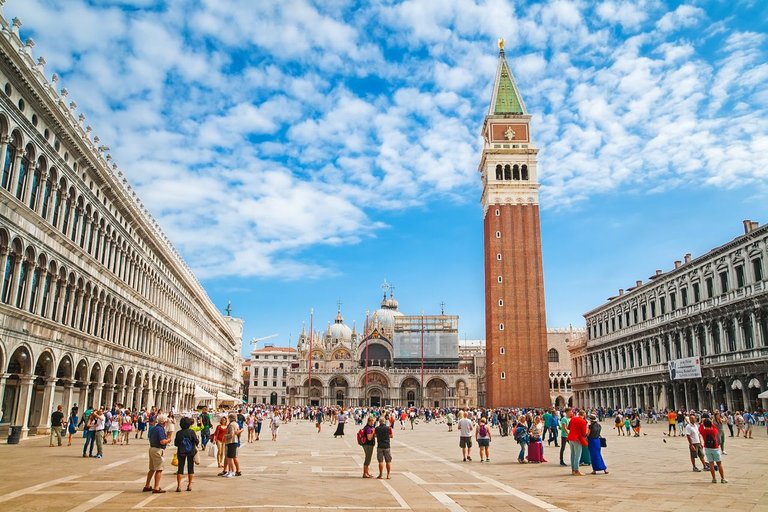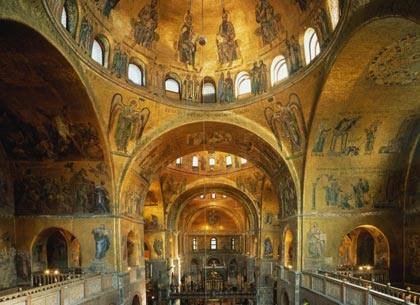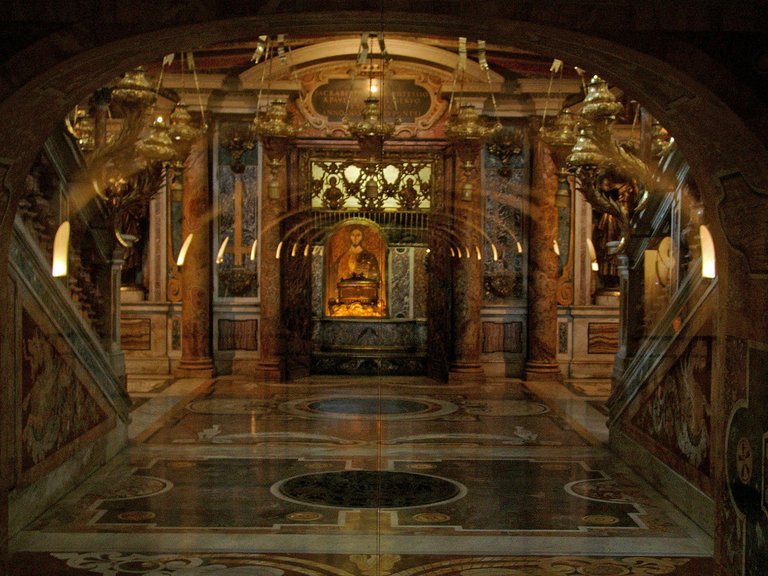Piazza San Marco
The Basilica of San Marco, also called Basilica Marciana, is the monument that best represents Venice and its ancient maritime and commercial power. The church overlooks Piazza San Marco and is adjacent to the Palazzo Ducale. It is the seat of the patriarch of Venice and contains the remains of St. Mark the Evangelist.
( )
)
The basilica stands on the remains of another church, in the place where the legend tells that an angel pointed to San Marco, in the verse towards Rome, the place of his burial;
The remains of the saint were kept in Alexandria and stolen in 828 by two Venetian merchants, Buono da Malamocco and Rustico da Torcello, who used to stop and pray on the tomb of the saint. The mortal remains of San Marco are transported to a nascent hidden in a basket of vegetables and pork. Once done in Venice, the doge ordered the construction of a new church to keep the saint's remains. This choice is strategically valid from the point of view of the relics of a saint, in the Middle Ages, it was the source of many gains.
It was consecrated in 1094. The city adopted as a symbol the symbol of San Marco, the lion with the sword that represents civil virtues, strength, courage.
The Basilica is fed by five domes resting on four times supported by four pillars.
During the centuries the church has undergone many transformations, often for political or representative reasons and has been enriched with immense treasures, also coming from the East. Inspired by the Church of the Twelve Apostles of Constantinople, its architecture is a mixture of Byzantine, Roman and Venetian and the hand of many different artists and of different origins can be seen.
To admire the facade of the church which is a masterpiece of Gothic sculpture divided into a double order of five arches. In the first arch found the mosaic "Traslazione del corpo di San Marco in the church"; in the second one "The body of San Marco revered by the doge". The bas-reliefs in the central area are the trades of Venice. In the fourth and fifth arch we find other mosaics always referred to San Marco. On the upper façade there are copies of Enrico Dandolo's horses spaced from Constantinople in the thirteenth century, after the Fourth Crusade. On the side overlooking the Doge's Palace you can admire the stone of the ban, from which the ordinances of the Republic were read.
The particular paving of the Church is clearly Byzantine inspiration. Within which are several animals, with reference to the symbols of medieval bestiaries.
The structure of the Basilica is a Greek cross with a central dome and on each span results four hemispherical domes on which, in the thirteenth century, small bulb domes are built.
Inside the church is decorated with marvelous mosaics with a golden background, representations concerning the life of the Holy episodes of the Old and New Testament, dating back to a period from the twelfth to the fourteenth century. In the Basilica they are very impressed by the grandeur and harmony of the volumes
The remains of San Marco are kept in the marble high altar behind which represent the masterpiece of the Byzantine and Venetian goldsmith, the "Pala d'oro". The word "pala" comes from the Latin "ball" or fabric and represents, the frieze behind the altar that embellishes the area reserved for the celebration. It was commissioned by the Doge Ordelaffo Falier in 1102 and depicts the Christ, the Doge and many scenes from the Old and New Testaments. The "Pala" is only open for liturgical feasts, while during the year it is covered by the so-called "Pala Feriale", a wooden painting made in the first half of the fifteenth century.
Differently from the Greek model, the altar is not placed at the center of the cross plan, but under the dome of the presbytery, located to the east.
The bell tower of the basilica that dates back to the tenth century, collapsed on July 14, 1902; it was rebuilt in 10 years brick by brick. From the top of the bell tower you can admire a fabulous view over the rooftops and the lagoon. ![sanmarco.06.jpg]
![sanmarco.06.jpg]
If you are in Italy and you want to visit it this are the price of tickets and the hours you can visit it :-D
Hours and Prices
November - March / April (Easter):
Basilica: 9.45 am - 5.00 pm - Sundays and public holidays: 2.00 pm - 4.00 pm (free admission)
Museum of San Marco: 9.45 am - 4.45 pm (admission: € 4 whole, a few € 2 only for groups of more than 15 people)
Golden shovel: 9.45am - 4.00pm - bank holidays: 2.00pm - 4.00pm (admission: € 2 full price, € 1 reduced only for groups over 15 people)
Treasure: 9.45am - 4.00pm - bank holidays: 2.00pm - 4.00pm (admission: € 3 inside, € 1.50 reduced only for groups over 15 people)
March / April (Easter) - November:
Basilica: 9.45 am - 5.00 pm - Sundays and public holidays: 2.00 pm - 5.00 pm (free admission)
Museum of San Marco: 9.45 am - 4.45 pm (admission: € 4 whole, a few € 2 only for groups of more than 15 people)
Golden shovel: 9.45 am - 5.00 pm - Sundays and public holidays: 2.00 pm - 5.00 pm (admission: € 2 full price, € 1 reduced only for groups over 15 people) Treasure: 9.45 am - 5.00 pm - Sundays and public holidays: 2.00 pm - 5.00 pm ( admission: € 3 whole, € 1.50 reduced only for groups over 15 people)
![a0e87686d0548faec922d8fbe9d13f45c0b3fdb9.jpg]
( )![Interno_della_basilica_di_san_marco,_venezia.jpg]
)![Interno_della_basilica_di_san_marco,_venezia.jpg]
( )![Petrusgrab_Petersdom_b.jpg]
)![Petrusgrab_Petersdom_b.jpg]
( )
)
very interesting